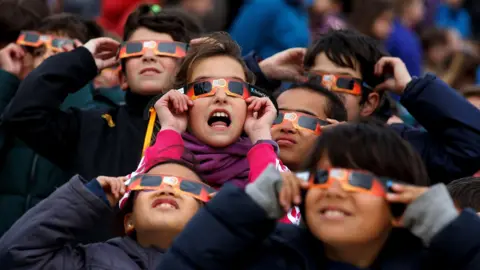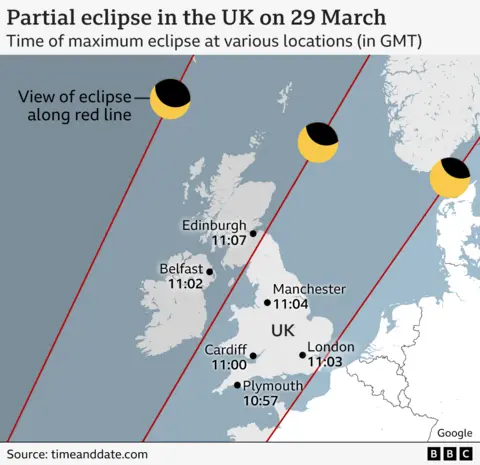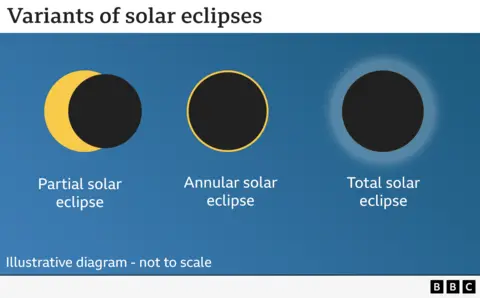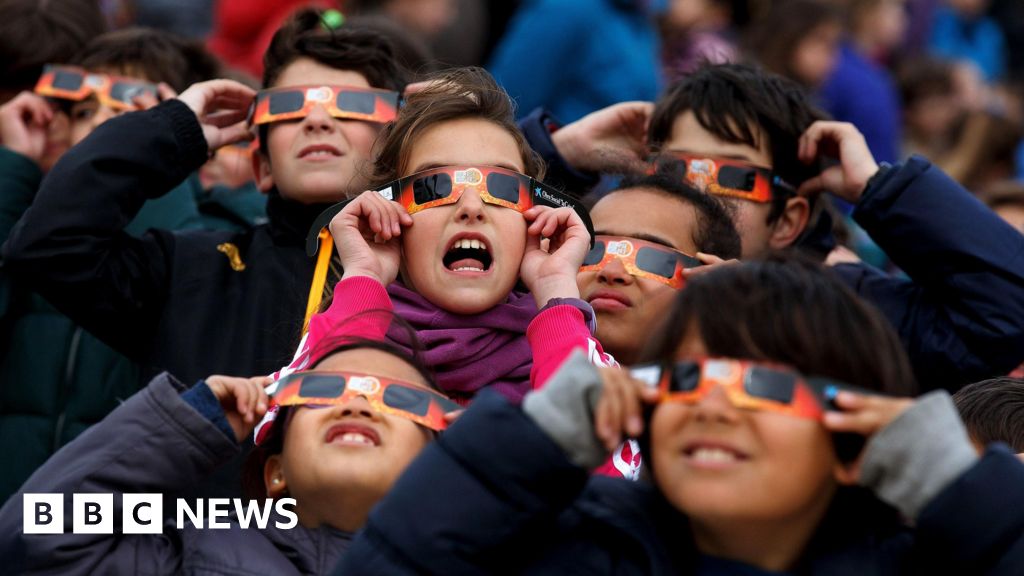BBC Climate & Science

Getty Images
Get your protective eclipse glasses ready – weather permitting you’ll be able to see the Moon take a ‘bite’ out of the Sun on Saturday morning.
The partial solar eclipse will be visible across the UK. People will have the chance to see the Moon cover about 30 to 50% of the Sun at its peak, with the best chance of clear skies in south-east England, East Anglia, and the Midlands.
The eclipse won’t be total anywhere in the world, but northeastern regions of Canada will see up to 92% of the Sun covered.
You must not ever look at the Sun directly, as it can severely damage your eyes, so you will need those special eclipse glasses if you’re going to take a peek.
When and where will the partial eclipse be seen?

This partial eclipse will be visible across Europe, Northwestern Africa, Greenland, Iceland, and parts of the northeastern US and eastern Canada, with varying levels of visibility.
It will begin at 10:07 in the UK and will end at midday.
Some parts of the UK will see more of the Sun covered than others. If you are in the Outer Hebrides, for example, you’ll see up to 47% of the Sun obscured, while Dover in southeast England will only see about 28% of it covered.
Eclipse times will vary slightly depending on where you are, so use Time and Date to check exact times in your location.
“This is an excellent chance to go out, look – safely – and to be able to see the movement of the solar system for yourself,” said said Anna Gammon-Ross, Senior Planetarium Astronomer at Royal Museums Greenwich.
“It’s such a wonderful way to just connect to everything happening and, and see it all in action.”
What Is a solar eclipse?

A solar eclipse occurs when the Moon moves between the Sun and Earth, blocking some or all the Sun’s light.
There are different types of solar eclipses, depending on how much of the Sun is obscured.
- Partial solar eclipse – The Moon partially covers the Sun, leaving a crescent-shaped section of the Sun visible.
- Annular solar eclipse – The Moon is directly in front of the Sun but appears smaller, leaving a thin, bright ring of sunlight around its edges.
- Total solar eclipse – The Moon completely covers the Sun, revealing a glowing outer atmosphere called the corona.
When and where is the next solar eclipse?
Skywatchers in the UK will be treated to another partial solar eclipse on August 12, 2026, when the Arctic, eastern Greenland, Iceland, and northern Spain will experience a rarer total eclipse.
The UK won’t witness another full solar eclipse for another 65 years, until September 23, 2090, according to the Royal Observatory in Greenwich.
The UK’s last total solar eclipse took place in 1999, with Cornwall being the only location in the country to experience the event in its totality, drawing thousands of people to the region.
How to watch a solar eclipse safely
<img decoding="async" sizes="(min-width: 1280px) 50vw, (min-width: 1008px) 66vw, 96vw" srcset="https://ichef.bbci.co.uk/news/240/cpsprodpb/0693/live/f17331a0-fffa-11ef-bf5e-e7d005fd4b0b.jpg.webp 240w,
https://ichef.bbci.co.uk/news/320/cpsprodpb/0693/live/f17331a0-fffa-11ef-bf5e-e7d005fd4b0b.jpg.webp 320w,
https://ichef.bbci.co.uk/news/480/cpsprodpb/0693/live/f17331a0-fffa-11ef-bf5e-e7d005fd4b0b.jpg.webp 480w,
https://ichef.bbci.co.uk/news/640/cpsprodpb/0693/live/f17331a0-fffa-11ef-bf5e-e7d005fd4b0b.jpg.webp 640w,
https://ichef.bbci.co.uk/news/800/cpsprodpb/0693/live/f17331a0-fffa-11ef-bf5e-e7d005fd4b0b.jpg.webp 800w,
https://ichef.bbci.co.uk/news/1024/cpsprodpb/0693/live/f17331a0-fffa-11ef-bf5e-e7d005fd4b0b.jpg.webp 1024w,
https://ichef.bbci.co.uk/news/1536/cpsprodpb/0693/live/f17331a0-fffa-11ef-bf5e-e7d005fd4b0b.jpg.webp 1536w" src="https://ichef.bbci.co.uk/news/480/cpsprodpb/0693/live/f17331a0-fffa


